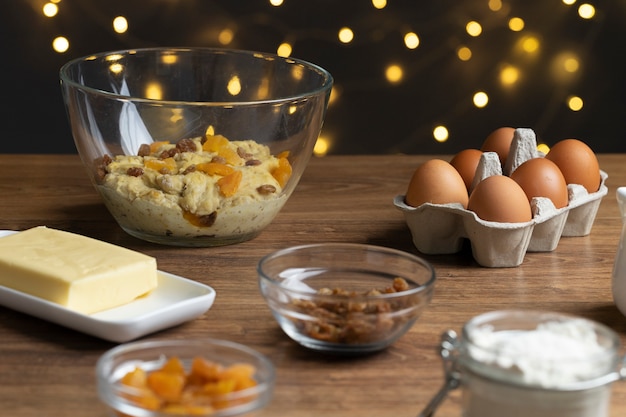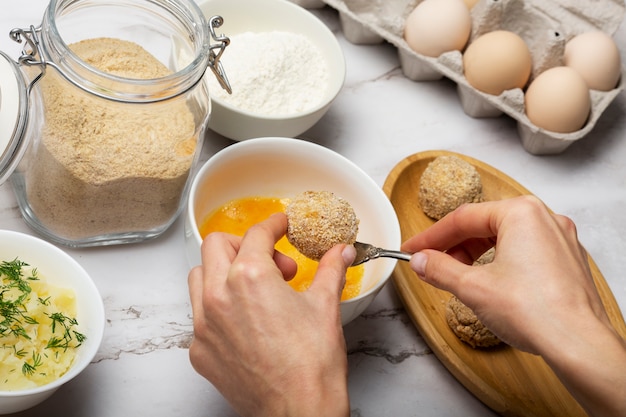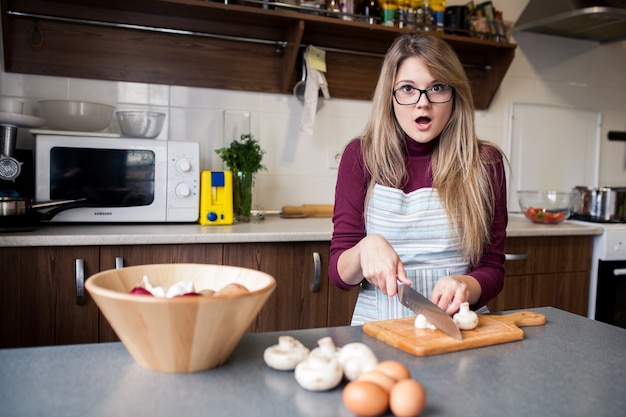Let's face it, folks. Boiling an egg seems like one of those things we should have mastered by now. How hard can it be to drop an egg in boiling water and wait? Well, my friends, there's a whole world of nuance and potential disaster lurking beneath the surface of that seemingly simple task. Trust me, I've learned the hard way (pun absolutely intended) that there's more to boiling an egg than meets the eye.
From the dreaded rubbery yolk, reminiscent of a bouncy ball, to the runny mess that's more like soup than breakfast, I've been there, done that, and worn the yolk-stained apron. But fear not, dear readers, for I'm here to share my hard-earned wisdom and guide you through the treacherous waters of egg-boiling.
(Part 1) The Great Egg-Boiling Conundrum

You see, the issue with boiling eggs is the elusive "perfect hard-boiled egg." We all have our own personal preferences, but achieving that elusive state of perfect hard-boiledness is a constant challenge, a bit like trying to find a decent cup of tea in this country (another story for another time).
There are those who swear by the "ten-minute rule," dropping their eggs in boiling water and timing it with a stopwatch like they're conducting a scientific experiment. And then there are those who scoff at such rigid rules, opting for the "immersion" method, gently lowering the eggs into simmering water for what feels like an eternity. And let's not forget the "slow and steady" brigade, who believe in bringing the eggs to a slow boil and then simmering them for what feels like a lifetime.
A Journey of Discovery
In my quest for the perfect hard-boiled egg, I've tried countless methods. I've experimented with different types of eggs, from free-range to organic, different pot sizes, different water temperatures, and even different methods of cooling. I've been known to meticulously track the time with a kitchen timer, muttering under my breath like a mad scientist. I've even considered investing in a fancy egg cooker, but let's be honest, that seemed a bit over the top for a simple boiled egg.
Through my trials and tribulations, I've learned that the key to a perfect hard-boiled egg is a combination of factors, not just one magic trick. And trust me, it's not always about following the exact recipe. Sometimes, you just gotta trust your gut.
(Part 2) Understanding the Science of Boiling an Egg

Before we dive into the nitty-gritty of boiling techniques, let's take a moment to understand the science behind this culinary marvel.
Essentially, when you boil an egg, you're applying heat to the proteins within the egg. The heat causes the proteins to denature and solidify, transforming the liquid whites and yolk into a firm, solid mass. The longer you boil the egg, the more the proteins denature and the firmer the egg becomes.
The Devil is in the Details
But here's the thing: different parts of the egg react to heat at different rates. The whites, being mostly water, solidify quickly. The yolk, on the other hand, takes longer to cook through, meaning that if you overcook the egg, you'll end up with a hard, rubbery yolk that's more akin to a rubber eraser than a creamy delight.
This is where the art of timing comes in. You want to cook the egg long enough for the white to set, but not so long that the yolk becomes overly firm. It's a delicate balance, my friends, a game of culinary precision.
(Part 3) The Essential Equipment for a Perfect Hard-Boiled Egg

Alright, let's talk about the tools of the trade. You don’t need a fancy kitchen gadget or a Michelin-star chef's expertise to achieve the perfect hard-boiled egg. You just need a few essential items.
- A Pot: Choose a pot that’s large enough to hold the eggs comfortably with at least an inch of water covering them. A medium-sized saucepan will do just fine.
- Cold Water: You need enough cold water to cover the eggs by at least an inch.
- Eggs: Pick eggs that are fresh, not too old. fresh eggs have a firmer white that sets quicker. If you're not sure, look for the "best before" date on the carton.
- Timer: A good old-fashioned kitchen timer is essential for keeping track of your egg-boiling time. No more guesswork!
- ice bath: An ice bath is crucial for stopping the cooking process and preventing the yolks from becoming rubbery. Simply fill a large bowl with ice and cold water. You can also use a colander and place it in a bowl of ice water for easier retrieval of the eggs.
With these simple tools, you're ready to embark on your egg-boiling journey!
(Part 4) The Traditional Method: Boiling for Ten Minutes
Now, let's talk about the most common method, the one that’s been handed down through generations, the ten-minute method. It’s a classic, a tried-and-true approach that's often mentioned in cookbooks and grandma’s recipe books.
- Get Started: Place the eggs in a saucepan and fill with cold water, making sure the water covers the eggs by at least an inch.
- Bring to a Boil: Bring the water to a rolling boil over high heat. You'll know it's boiling when the water starts bubbling vigorously.
- Time It: Once the water is boiling, set your timer for ten minutes.
- Cool Down: After ten minutes, drain the hot water and immediately place the eggs in a bowl of ice water. Leave the eggs in the ice bath for at least five minutes to stop the cooking process. This will also make the eggs easier to peel.
The ten-minute method is a good starting point, but it might not be ideal for everyone. The firmness of the yolk will depend on the freshness of the eggs, the size of the eggs, and even the altitude.
(Part 5) The Immersion Method: Slow and Steady
If you’re not a fan of the ten-minute rule, or if you’re looking for a more delicate approach, the immersion method might be more your style. This method involves gently lowering the eggs into simmering water.
- Start Gently: Fill a saucepan with cold water and bring it to a simmer over medium heat. The water should be just below a rolling boil, with small bubbles gently rising to the surface.
- Lower the Eggs: Carefully lower the eggs into the simmering water using a slotted spoon. This will prevent the eggs from cracking when they hit the hot water.
- Simmer: Simmer the eggs for 12-15 minutes, depending on how firm you like your yolks. If you want a firmer yolk, simmer for 15 minutes. If you prefer a softer yolk, simmer for 12 minutes.
- Cool Down: After simmering, drain the hot water and immediately place the eggs in a bowl of ice water. Leave the eggs in the ice bath for at least five minutes to stop the cooking process.
The immersion method is often praised for producing more evenly cooked eggs, but it can take a bit longer. The key is to keep the water at a gentle simmer and to avoid letting it boil too vigorously.
(Part 6) The Slow-Boil Method: Taking Your Time
For those who believe in the virtues of slow and steady, the slow-boil method is a good option. This method involves bringing the eggs to a gentle boil and then simmering them for a longer period.
- Start Slow: Fill a saucepan with cold water and place the eggs in the water.
- Bring to a Gentle Boil: Bring the water to a gentle boil over low heat. It should be a slow, gentle simmer, with barely any visible bubbles.
- Simmer Slowly: Simmer the eggs for 15-20 minutes, depending on how firm you like your yolks.
- Cool Down: After simmering, drain the hot water and immediately place the eggs in a bowl of ice water. Leave the eggs in the ice bath for at least five minutes to stop the cooking process.
The slow-boil method is often said to produce more tender yolks, but it does require a bit more patience. The key is to keep the water at a gentle simmer and to avoid letting it boil too vigorously.
(Part 7) Beyond the Basics: Advanced Tips for perfect eggs
Now, let's delve into some advanced tips and tricks that can elevate your egg-boiling game. These techniques might seem a bit fancy, but trust me, they make a difference.
Adding Salt or Vinegar
Some folks swear by adding salt or vinegar to the boiling water. They say that this helps to prevent the eggs from cracking and that it adds flavor to the eggs. I've tried both methods, and honestly, I haven’t noticed a significant difference. But hey, if it makes you feel like a culinary master, go for it.
Cooling the Eggs Quickly
Here’s a little secret, my friends: the key to a perfectly cooked egg is not just the boiling time but also the cooling process. You see, when you stop the cooking process quickly, you prevent the yolk from continuing to cook and becoming overly firm. So, make sure to cool your eggs down quickly in an ice bath.
Peeling the Eggs
Peeling a hard-boiled egg can be a bit of a challenge. Some people swear by tapping the egg on a counter, others prefer rolling it gently between their hands. Personally, I find that adding a spoonful of baking soda to the boiling water makes the shells easier to peel. The baking soda helps to weaken the egg's membrane, making the shell less likely to stick to the white.
(Part 8) FAQs: Your Egg-Boiling Questions Answered
So, you’ve learned the basics of egg-boiling, but you’re still itching for answers. Here are some frequently asked questions to help you conquer the egg-boiling challenge once and for all.
1. What is the best way to peel a hard-boiled egg?
The best way to peel a hard-boiled egg is to gently tap the egg on a flat surface and then roll it gently between your hands. This will create small cracks in the shell, making it easier to peel. If you find that the shell is still sticking, try adding a spoonful of baking soda to the boiling water. Another trick is to start peeling from the wider end of the egg, where the air pocket is located.
2. Why do some eggs have a green ring around the yolk?
The green ring around the yolk is a result of overcooking. When the egg is cooked for too long, the iron in the yolk reacts with the sulfur in the white, creating a green compound called ferrous sulfide. This is more likely to happen if the eggs are boiled for an extended period or at a high temperature.
3. Can you boil eggs in the microwave?
Yes, you can boil eggs in the microwave. However, it is not recommended as it can result in uneven cooking and potentially explode the eggs. The uneven heating can cause the egg to explode or create an uneven texture. If you’re looking for a quick way to cook eggs, try using a microwave egg cooker.
4. How long should I boil eggs for a soft-boiled egg?
For a soft-boiled egg, you should boil the eggs for 3-4 minutes. This will result in a runny yolk and a firm white. For a more runny yolk, try boiling for 2-3 minutes. For a firmer yolk, try boiling for 4-5 minutes.
5. Can I reuse the same water for boiling eggs multiple times?
It is not recommended to reuse the same water for boiling eggs multiple times. The water can become contaminated with bacteria from the eggshells. Even though the water is boiling, bacteria can survive and potentially cause food poisoning.
(Part 9) The Art of the Egg: Beyond the Boil
Now that you've mastered the art of boiling the perfect hard-boiled egg, let's explore some creative culinary adventures with your perfectly cooked eggs.
hard-boiled eggs are incredibly versatile. They're great for breakfast, lunch, or a snack. You can add them to salads, sandwiches, or deviled eggs. You can even use them to make egg salad, a classic picnic food.
Deviled Egg Delight
Here's a simple recipe for deviled eggs:
| Ingredient | Quantity |
|---|---|
| Hard-boiled eggs | 6 |
| Mayonnaise | 1/2 cup |
| Mustard | 1 tablespoon |
| Salt | 1/2 teaspoon |
| Pepper | 1/4 teaspoon |
| Paprika | 1/4 teaspoon |
- Peel the hard-boiled eggs and slice them in half lengthwise.
- Remove the yolks and place them in a bowl.
- Mash the yolks with a fork until smooth.
- Add the mayonnaise, mustard, salt, pepper, and paprika.
- Mix well until the ingredients are combined.
- Spoon the yolk mixture back into the egg whites.
- Sprinkle with paprika for a festive touch.
- Refrigerate until chilled and enjoy!
(Part 10) Conclusion: The Journey Continues
So there you have it, my friends, a comprehensive guide to boiling the perfect hard-boiled egg. But remember, the quest for the perfect egg is a never-ending journey. There will always be new techniques to try, new discoveries to make, and new recipes to explore.
So, grab your eggs, your pot, and your timer, and embark on your own egg-boiling adventure. May your yolks be firm, your whites be set, and your eggs be perfectly cooked. Happy boiling!
Everyone is watching

How to Cook Frozen Lobster Tails Perfectly: A Step-by-Step Guide
RecipesLobster. Just the word conjures up images of lavish meals, special occasions, and a taste of luxury. But let's...

Pigs in a Blanket Cooking Time: How Long to Bake for Perfect Results
RecipesAh, pigs in a blanket. Just the name conjures up images of those delightful little parcels of crispy pastry en...

Pork Fillet Cooking Time: How Long to Cook It Perfectly
RecipesPork fillet, or tenderloin as it's sometimes called, is a real favourite in our house. It's so versatile, and...

The Ultimate Guide to Tender, Juicy Pulled Pork
RecipesRight, let's talk pulled pork. It's one of those dishes that just screams "comfort food," doesn't it? I mean...

The Ultimate Guide to Cooking Sweet Potatoes: From Roasting to Mashing
RecipesSweet potatoes. Just the name conjures up images of warm, comforting dishes, bursts of vibrant color, and a to...
